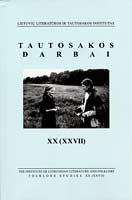Trijų muzikinės kultūros sluoksnių sandūra lietuvių mirusiųjų pagerbimo apeigose
Combination of three layers of musical culture in lithuanian funeral rites
Author(s): Aušra ŽičkienėSubject(s): Customs / Folklore
Published by: Lietuvių literatūros ir tautosakos institutas
Keywords: Funeral music; funeral lementatuion; catholic folk style
Summary/Abstract: Nowadays in Lithuanian funeral customs it is possible to discern manifestations of three layers of the musical culture: – the pre-Christian layer, i.e. female lamentations near the deceased relative; – the Christian layer, represented by Catholic folk-style chanting (unrelated to the Church liturgy) at the deceased one’s side; – the modern layer; i.e. playing records or live music of various styles according to the listeners’ taste. The modern layer of the musical culture is different from the previous ones mainly because music is losing its role as means of direct emotional expression, as way of pouring out grief and performing the ritual. Nowadays especially in the urban environment, but even at the countryside, silence becomes increasingly accepted at funerals. Quiet and peaceful music is usually played somewhere in the background, but participants of the funeral no longer take part in its creation and performance. They are just listeners, and music acquires a secondary function of creating the appropriate solemn mood and enhancing meditation. Does this mean a radical change of musical expression during funerals? The musical layers in these rituals are essentially different both by their origin, structure, and ways of expression, yet they are linked by the same intention, creating grounds for their long-term co-existence and gradual assimilation. The modern layer of musical expression is prevalent at funerals in contemporary cities and often in villages nowadays. But this layer also absorbs some specific features of the earlier ones. Music is played at funerals only if it is perceived as suitable to honor the deceased. Thus we have to consider the existence of uninterrupted direct continuation of the funeral tradition. Like many centuries ago, death and funeral traditions still constitute one of the cardinal transformations in the circle of human life.
Journal: Tautosakos darbai
- Issue Year: 2004
- Issue No: 27
- Page Range: 59-64
- Page Count: 6
- Language: Lithuanian

